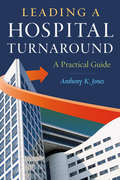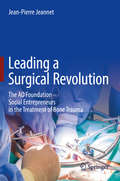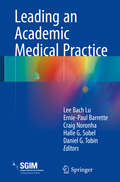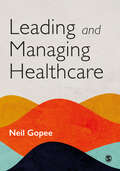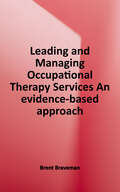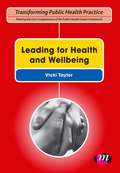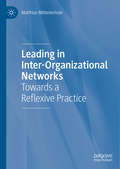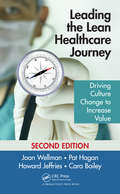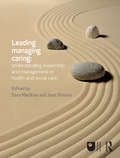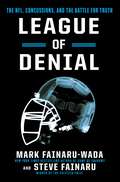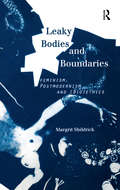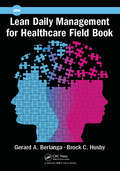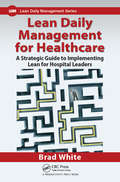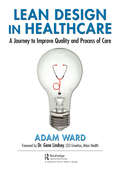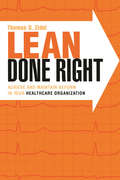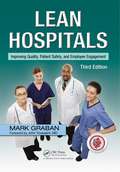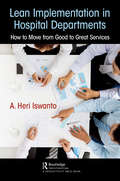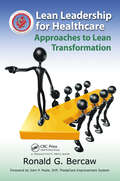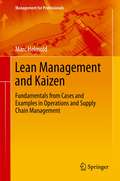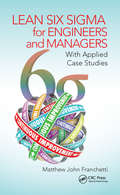- Table View
- List View
Leading a Hospital Turnaround A Practical Guide (ACHE Management)
by Anthony JonesNo healthcare organization is immune to financial decline. Healthcare leaders must be able to recognize the warning signs of financial distress and take action to maintain or restore their organization’s financial health. The author of this step-by-step guide shares what he learned while leading several successful financial turnarounds. Along with concrete tools and action plans, he provides candid advice about minimizing the fears of employees, physicians, and board members. In this book, you will learn how to preserve crucial relationships while directly addressing difficult questions. Topics covered include: Using performance analytics to predict a financial crisis Acknowledging a negative financial trend and accepting responsibility Improving cash flow and reducing costs Initiating pivotal discussions with key stakeholders Creating an effective communications and public relations strategy Developing a dashboard for the turnaround process Fielding the right turnaround team and determining responsibilities Maintaining strong relationships with your medical staff Avoiding common leadership missteps Considering the use of outside consultants Creating closure after a turnaround
Leading a Surgical Revolution: The AO Foundation – Social Entrepreneurs in the Treatment of Bone Trauma
by Jean-Pierre JeannetThis book describes the 60-year history of the AO Foundation and its impact on the treatment of bone trauma. Originally founded by a group of Swiss surgeons, the AO has since established its osteosynthesis treatment approach to trauma, using surgery and implants, as the global standard. The AO successfully convinced the medical community that surgery of bone trauma was superior to the standard conservative treatment using plaster casts. This new technique meant that patients no longer had to spend long weeks at the hospital in traction, and prevented many disabilities. This book describes the struggle with the medical community, explains how the AO surgeons enlisted the support of an entire industry for their advanced tools and their research and teaching efforts, and details the AO’s evolution into a non-profit foundation that now trains more than 50,000 surgeons, on all continents, every year. The efforts of the AO’s affiliated surgeons, undertaken largely on a volunteer basis and with their own financial resources, serve as a stellar example of social entrepreneurship. Today the AO Foundation numbers over 20,000 surgeon members worldwide, and the industry that emerged to produce related implants and tools employs thousands of skilled staff. Professionals in consulting as well as in healthcare can use this book as a source of successful strategies, and as a blueprint for active social entrepreneurship.
Leading an Academic Medical Practice
by Halle G. Sobel Daniel G. Tobin Lee B. Lu Robert J. Fortuna Craig F. NoronhaAuthored and edited by a prestigious team of academic clinician-educators affiliated with the Society of General Internal Medicine (SGIM), this now fully updated and expanded second edition of Leading an Academic Medical Practice provides a roadmap for clinic directors, core faculty, and educational leaders seeking to develop and administer a successful and cutting-edge academic medical practice. Each chapter of this book focuses on a particular aspect of clinic leadership and offers real-world examples and management "pearls" to help readers translate theory into practice. In addition to updated core content on topics such as Accreditation Council for Graduate Medical Education (ACGME) requirements, ambulatory curricula, clinical workflows, billing & coding, population health, evaluation and feedback, patient-centered medical home (PCMH) implementation, controlled substance policies, and student engagement, this new edition also focuses on issues particularly relevant for today's medical practice including social justice, diversity in residency practices, healthcare advocacy, physician burnout, telemedicine, and crisis management (e.g., public health emergencies). This resource is an ideal companion for academic clinician-educators across all levels of training and experience. Aspiring and new clinic directors will find this book offers essential tools to get started, and seasoned clinic leaders can use this publication to elevate their practice to the next level. In addition to clinic directors, core faculty, and administrative and educational leaders in academic outpatient medicine, healthcare specialists focused on system-based practice, quality-improvement, and patient safety will also find this resource valuable. Those working within the fields of primary care, internal medicine, and related specialties will find this book to be of special relevance. Now more than ever, the complexities of leading an academic medical practice present a unique challenge. This book, both comprehensive and practical, will help to overcome these challenges today and in the years to come.
Leading an Academic Medical Practice
by Lee Bach Lu Ernie-Paul Barrette Craig Noronha Halle G. Sobel Daniel G. TobinThis book informs and supports medical educators and clinic leaders regarding the key clinical and administrative components necessary to run an academic medical practice. From a group of expert faculty from the Society of General Internal Medicine (SGIM) with years of experience in managing academic medical practices, this manual offers comprehensive guidance to the clinic director regarding critical factors involved with running an academic medical practice including, but not limited to: compliance with Accreditation Council for Graduate Medical Education (ACGME) requirements, clinic orientation and curricula implementation, clinic workflow challenges, billing, coding, and the Primary Care Exception Rule, productivity metrics and quality indicators, evaluation and feedback for trainees, faculty, and clinic staff, implementation of a Patient Centered Medical Home (PCMH), development of controlled substance prescribing policies, medical student involvement in resident clinics, and Veteran Affairs practices and non-traditional care settings. The scope of this book is sufficiently broad to be comprehensive and practical while still anticipating the further evolution of the academic medical practice in the years to come. Each chapter focuses on a particular aspect of clinic leadership and will offer real-world examples and management “pearls” for the clinic director. Chapters highlight common challenges and solutions and should be useful across disparate practice settings. This is an ideal resource for clinic directors, core faculty, and clinic leadership in academic outpatient medical practices, particularly those within the field of Internal Medicine, Primary Care, and related specialties.
Leading and Managing Health Services
by Gary E. Day Sandra G. LeggatLeading and Managing Health Services: An Australasian Perspective provides a comprehensive overview of leadership and management in health services with a particular focus on the Australasian context. This text aims to help students develop leadership and management skills, and to critically analyse the issues they will face in practical health service settings. The book features a contemporary approach to learning, in line with the Health LEADS Australia framework which focuses on five key leadership attributes: Leads self, Engages systems, Achieves outcomes, Drives innovations and Shapes systems. Further, it offers a rich pedagogy both in the text and companion website. Chapters include case studies to provide examples of management and leadership issues in healthcare settings, and a wealth of reflective, short answer and multiple-choice questions to extend student learning. Written by respected Australian academics and industry experts, this text will equip health professional students with practical skills to successfully manage change and innovation.
Leading and Managing Healthcare
by Neil GopeeThis textbook has been created to support the journey from emerging registered healthcare professional through to becoming a competent frontline care setting manager. It considers the seminal theories and research into leadership and management and places them firmly into the healthcare context providing the reader with thorough and robust guidance in the application of the knowledge base in the subject area. Key features: Integration of theory and practice using Action Points and case studies throughout Includes perspectives from a wide range of healthcare settings and professional groups Each chapter includes ′Guidance on good practice′ showing what high-quality care and effective change looks like Written by a vastly experienced author, practitioner and educator, this latest book from Neil Gopee is essential reading for nursing, health and social care students taking modules on leadership, management and transition to practice in their final year. It is also ideal for newly qualified professionals or those moving into band 5 or 6 roles with managerial responsibilities.
Leading and Managing Healthcare
by Neil GopeeThis textbook has been created to support the journey from emerging registered healthcare professional through to becoming a competent frontline care setting manager. It considers the seminal theories and research into leadership and management and places them firmly into the healthcare context providing the reader with thorough and robust guidance in the application of the knowledge base in the subject area. Key features: Integration of theory and practice using Action Points and case studies throughout Includes perspectives from a wide range of healthcare settings and professional groups Each chapter includes ′Guidance on good practice′ showing what high-quality care and effective change looks like Written by a vastly experienced author, practitioner and educator, this latest book from Neil Gopee is essential reading for nursing, health and social care students taking modules on leadership, management and transition to practice in their final year. It is also ideal for newly qualified professionals or those moving into band 5 or 6 roles with managerial responsibilities.
Leading and Managing Occupational Therapy Services: An Evidence-Based Approach
by Brent BravemanBe prepared to lead, manage, and supervise OTs, OTAs, and interprofessional health care teams. Whatever your role, the practical knowledge and the guidance you'll find here will help you become a more effective OT practitioner, colleague, and manager. Use evidence to guide your leadership and managerial decision-making. This practical text introduces you to leadership and management theory, research, data, and evidence, and shows you how to apply them! From leadership and supervision to policies, program development, and continuous quality improvement, you'll find complete coverage of the full range of leadership and managerial functions. Critical-thinking questions, real-life cases, and vignettes build the connections between theory, evidence, and practice.
Leading and Managing in Nursing (6th Edition)
by Patricia S. Yoder-WiseLeading and Managing in Nursing, 6th Edition offers an innovative approach to leading and managing by merging theory, research, and practical application to better prepare you for the NCLEX® exam and the transition to the practice environment. This cutting-edge text is organized around the issues that are central to the success of professional nurses in today's constantly changing healthcare environment, including consumer relationships, cultural diversity, resource management, delegation, and communication.
Leading for Health and Wellbeing (Transforming Public Health Practice Series)
by Vicki Taylor′Building on the core competences for public health, this book focuses on the key areas of leadership and collaborative working to improve health and wellbeing. Aimed at those undertaking Masters courses in public health and health promotion, (as well as those seeking to gain public health registration through the compilation and submission of a portfolio) this book focuses on leadership and collaborative working to improve health and wellbeing. Leadership, building alliances, developing capacity and capability, working in partnership with other practitioners, agencies and communities, understanding different organisational stuctures and cultures and working effectively across organisational boundaries are central themes throughout this book. Leadership skills such as negotiation, persuasion and influencing and the nature of power and the importance of understanding one′s self and the communication process and project management skills and leading and managing change to improve health and wellbeing are considered. Case studies, activities and research summaries are used throughout the book to help the reader to understand how to apply the theory to practice.
Leading in Inter-Organizational Networks: Towards a Reflexive Practice
by Matthias MitterlechnerIn view of the rising importance and prevalence of network-based collaboration, this book aims to meet the need for more theory in this area. Theoretically conceptualizing and empirically describing the practice of reflexive leadership in inter-organisational networks, it explores how member organisations approach reflexive leadership and the associated challenges. Examining these questions from wider leadership theory perspectives as well as a tighter focus upon inter-organizational networks, the author specifically explores how reflexive leadership can be sustained and how social and political contexts may obstruct or support its use, acceptance and practice. Based on in-depth qualitative empirical fieldwork in the Swiss healthcare sector, the book offers a novel practice-theoretical model for use in inter-organizational networks.
Leading the Lean Healthcare Journey: Driving Culture Change to Increase Value, Second Edition
by Joan Wellman Pat Hagan Howard Jeffries Cara BaileyThis book reveals and describes the leadership and culture change required to remove waste from healthcare processes and eliminate the root cause of soaring costs, poor quality and safety, and limited access. The book's delivery strategy revolves around personal and organizational stories and case studies told by physician and administrative leaders, all students of the Toyota Production System. This revised edition uniquely blends updated case studies with practical theory to describe how the healthcare value proposition can be changed by reducing waste, variation and complexity in healthcare. New to the book are chapters on clinical standard work and integration of lean and safety.
Leading, Managing, Caring: Understanding Leadership And Management In Health And Social Care
by Sara MacKian; Joan SimonsEffective leadership and management in health and social care are built on good practice, strong relationships and a critical understanding of the wider context in which care takes place. Leading, Managing, Caring illustrates how leadership and management work in everyday settings, providing invaluable support to those practising or studying in the area. The book introduces the four core building blocks of the caring manager or leader: personal awareness, team awareness, goal awareness and contextual awareness. Together these form a firm foundation for understanding and practice. Drawing on up-to-date case studies, the authors explore how critical theoretical understanding can support practical attempts to work through complex situations with a diverse range of people. Also included is a toolkit containing carefully selected and practical tools for leading and managing change. This comprehensive textbook is suitable for existing and aspiring managers and leaders in a range of health and social care professions, or anyone interested in understanding more about the complex landscape in which care services are managed and delivered in the UK.
League of Denial: The NFL, Concussions, and the Battle for Truth
by Mark Fainaru-Wada Steve Fainaru"PROFESSIONAL FOOTBALL PLAYERS DO NOT SUSTAIN FREQUENT REPETITIVE BLOWS TO THE BRAIN ON A REGULAR BASIS." <P><P>So concluded the National Football League in a December 2005 scientific paper on concussions in America's most popular sport. That judgment, implausible even to a casual fan, also contradicted the opinion of a growing cadre of neuroscientists who worked in vain to convince the NFL that it was facing a deadly new scourge: A chronic brain disease that was driving an alarming number of players -- including some of the all-time greats -- to madness. <P><P>League of Denial reveals how the NFL, over a period of nearly two decades, sought to cover up and deny mounting evidence of the connection between football and brain damage. <P><P>Comprehensively, and for the first time, award-winning ESPN investigative reporters Mark Fainaru-Wada and Steve Fainaru tell the story of a public health crisis that emerged from the playing fields of our 21st century pastime. Everyone knew that football is violent and dangerous. But what the players who built the NFL into a $10 billion industry didn't know - and what the league sought to shield from them - is that no amount of padding could protect the human brain from the force generated by modern football; that the very essence of the game could be exposing these players to brain damage. <P><P>In a fast-paced narrative that moves between the NFL trenches, America's research labs and the boardrooms where the NFL went to war against science, League of Denial examines how the league used its power and resources to attack independent scientists and elevate its own flawed research -- a campaign with echoes of Big Tobacco's fight to deny the connection between smoking and lung cancer. <P><P>It chronicles the tragic fates of players like Hall of Fame Pittsburgh Steelers center Mike Webster, who was so disturbed at the time of his death he fantasized about shooting NFL executives; and former Chargers great Junior Seau, whose diseased brain became the target of an unseemly scientific battle between researchers and the NFL. <P><P>Based on exclusive interviews, previously undisclosed documents and private emails, this is the story of what the NFL knew and when it knew it - questions at the heart of crisis that threatens football, from the highest levels all the way down to Pop Warner.
Leaky Bodies and Boundaries: Feminism, Postmodernism and (Bio)ethics
by Margrit ShildrickDrawing on postmodernist analyses, Leaky Bodies and Boundaries presents a feminist investigation into the marginalization of women within western discourse that denies female moral agency and embodiment. With reference to contemporary and historical issues in biomedicine, the book argues that the boundaries of both the subject and the body are no longer secure. The aim is both to valorise women and to suggest that 'leakiness' may be the very ground for a postmodern feminist ethic. The contribution made by Leaky Bodies and Boundaries is to go beyond modernist feminisms to radically displace the mechanisms by which women are devalued. The anxiety that postmodernism cannot yield an ethics, nor advance feminist concerns is addressed. This book will provide invaluable reading for those studying feminist philosophy, cultural studies and sociology.
Lean Daily Management for Healthcare Field Book
by Gerard A. Berlanga Brock C. HusbyThis book gives healthcare leaders a practical guide to implementing the 4 key components of lean daily management system - 1. LDM boards; 2. Leadership rounds 3. Leader daily disciplines and 4. Lean projects. Although lean is not new to healthcare, effective LDM is just now taking hold with the best lean healthcare organizations in the U.S. and Canada. Leaders are realizing that sustaining their lean projects over time has proven to be a challenge without first addressing the organizations management system/model. LDM gives leaders a straightforward approach to do just that as well as improve their ability to spread and deploy lean to other areas of the organization and tie back to strategy.
Lean Daily Management for Healthcare: A Strategic Guide to Implementing Lean for Hospital Leaders
by Brad WhiteYou likely don’t need any more tools, programs, or workshops to improve your hospital. What you need is a simple and consistent approach to manage problem-solving. Filling this need, this book presents a Lean management system that can help break down barriers between staff, directors, and administration and empower front-line staff to resolve their own problems.Lean Daily Management for Healthcare: A Strategic Guide to Implementing Lean for Hospital Leaders provides practical, step-by-step guidance on how to roll out Lean daily management in a hospital setting. Ideal for leaders that may feel lost in the transition process, the book supplies a roadmap to help you identify where your hospital currently is in its Lean process, where it’s headed, and how your role will change as you evolve into a Lean leader.Illustrating the entire process of implementing Lean daily management, the book breaks down the cultural progression of units into discreet, objectively measurable phases. It identifies what leaders at all levels of the organization must do to progress units into the next phase of development.Complete with case studies from different service areas in the hospital, the book explains how to link problem-solving boards together to achieve meaningful and measurable improvements in: the emergency department, the operating room, discharge times, clinics, quality, and patient satisfaction.After reading this book you will understand how consistent rounding, a few whiteboards, pen-and-paper data, and a focused effort on working the Plan-Do-Study-Act cycle can help you build a common problem-solving bench strength throughout your organization—establishing the framework upon which future improvement can be built.
Lean Design in Healthcare: A Journey to Improve Quality and Process of Care
by Adam WardThis book gives the reader an inside look at creating a new healthcare service using practical examples and scenarios one would face if doing it themselves. This book chronicles the journey of a fictitious healthcare delivery organization using the Simpler Design System principles based on Lean methodologies. While the characters and actual story is fictitious, it is based on the journey many healthcare systems and clients have taken, the issues they have faced, and the successes and failures they’ve had. Tools and approaches used are based on the actual work of Simpler. The story format engages readers and is intended to motivate and inspire executive teams to use the tenets of the book as a guide to launch their own successful implementation of an idea-to-launch methodology. Tools include those gleaned from actual application of Lean Product Development, Agile, Design for Six Sigma, and Design Thinking Principles. Through engaging storytelling and practical theory, this book is written from the perspective of a physician leader that agrees to be the executive sponsor for a service redesign. As the story progresses, the sponsor becomes fascinated with the process and becomes the first VP of Innovation within his organization.
Lean Done Right: Achieve and Maintain Reform in Your Healthcare Organization (ACHE Management)
by Thomas ZidelWinner of the Axiom Business Book Award Silver Medal - Operations Management and Shingo Research and Professional Publication Award! Your healthcare organization cannot afford to waste time, money, or resources on an improper Lean implementation. You want to create a culture of continuous improvement, not a regime of tools that address problem areas but have short-lived results. Lean Done Right: Achieve and Maintain Reform in Your Healthcare Organization provides a roadmap for launching a transformative and sustainable Lean initiative. The Lean implementation model focuses on strategically directed action, developing a lean organizational culture, and enhancing the care delivery system. Chapters include: Death by Kaizen Event A Lean Implementation Model Strategically Directed Action The Culture-Creating Path Implement the Value Stream Work Plan The System-Creating Path Instructor Resources: PowerPoint slides of the exhibits from selected chapters.
Lean Hospitals: Improving Quality, Patient Safety, and Employee Engagement, Third Edition
by Mark GrabanOrganizations around the world are using Lean to redesign care and improve processes in a way that achieves and sustains meaningful results for patients, staff, physicians, and health systems. Lean Hospitals, Third Edition explains how to use the Lean methodology and mindsets to improve safety, quality, access, and morale while reducing costs, increasing capacity, and strengthening the long-term bottom line.This updated edition of a Shingo Research Award recipient begins with an overview of Lean methods. It explains how Lean practices can help reduce various frustrations for caregivers, prevent delays and harm for patients, and improve the long-term health of your organization.The second edition of this book presented new material on identifying waste, A3 problem solving, engaging employees in continuous improvement, and strategy deployment. This third edition adds new sections on structured Lean problem solving methods (including Toyota Kata), Lean Design, and other topics. Additional examples, case studies, and explanations are also included throughout the book.Mark Graban is also the co-author, with Joe Swartz, of the book Healthcare Kaizen: Engaging Frontline Staff in Sustainable Continuous Improvements, which is also a Shingo Research Award recipient. Mark and Joe also wrote The Executive’s Guide to Healthcare Kaizen.
Lean Implementation in Hospital Departments: How to Move from Good to Great Services
by A. Heri IswantoLean healthcare is waste elimination in every service area with the goal of reducing inventory, cycle time of service, and cost, so that high-quality patient care can be provided in a way that is as efficient, as effective, and as responsive as possible while retaining the financial integrity of a hospital. The Lean philosophy in healthcare demands a person’s attitude, in all aspects of care, understand the process which happens, observe it, and gather information in order to identify the root of an inefficiency of the process. In short, Lean and its emphasis on efficiency can be a critical tool in the management of health services in hospitals around the world. This book provides guidance and examples on how Lean principles can be implemented into the infrastructure and every day operations of a hospital from the emergency room to hospital facilities and maintenance. The book also demonstrates how Lean is the cultural commitment of organizations to implement the scientific method in designing, conducting, and improving work sustainably through teamwork, bringing in better value and satisfaction to the patient. It shortens the time between ordering and service delivery by eliminating waste from the service flow value. The author uses numerous examples of Lean thinking in various hospital departments with the overall of goal of taking that department from good to great.
Lean Leadership for Healthcare: Approaches to Lean Transformation
by Ronald BercawHealthcare organizations that have already applied Lean thinking to their processes, with the diligence of effective management and strong leadership support, are now realizing the benefits of their efforts. And, many of those benefits surpass what was thought possible just a few years ago. To be successful, these organizations had to provide the l
Lean Management and Kaizen: Fundamentals from Cases and Examples in Operations and Supply Chain Management (Management for Professionals)
by Marc HelmoldThe book provides a holistic and practical approach to lean management throughout the business value chain. The lean management framework and tools demonstrate the optimal design and use of methods, tools and principles for companies and organisations. The author describes comprehensively how lean management enables companies to concentrate on value-adding activities and processes to achieve a long-term, sustainable competitive advantage. A wealth of best practices, industry examples and case studies are used to reveal the diversity and opportunities of lean management methodologies, methods and principles. Moreover, the book shows how lean management principles are ultimately applied in industries like automotive, healthcare, education and services industries.
Lean Six Sigma Case Studies in the Healthcare Enterprise
by Sandra L. FurtererThis book provides a detailed description of how to apply Lean Six Sigma in the health care industry, with a special emphasis on process improvement and operations management in hospitals. The book begins with a description of the Enterprise Performance Excellence (EPE) improvement methodology developed by the author that links several methodologies including systems thinking, theory of constraints, Lean and Six Sigma to provide an enterprise-wide prioritization and value-chain view of health care. The EPE methodology helps to improve flow at the macro or value-chain level, and then identifies Lean Six Sigma detailed improvements that can further improve processes within the value-chain. The book also provides real-world health care applications of the EPE and Lean Six Sigma methodologies that showed significant results on throughput, capacity, operational and financial performance. The Enterprise Performance Excellence methodology is described, and also the Six Sigma DMAIC (Define-Measure-Analyze-Improve-Control) problem solving approach which is used to solve problems for health care processes as they are applied to real world cases. The case studies include a wide variety of processes and problems including: emergency department throughput improvement; operating room turnaround; operating room organization; CT imaging diagnostic test reduction in an emergency department; linen process improvement; implementing sepsis protocols in an emergency department; critical success factors of an enterprise performance excellence program.
Lean Six Sigma for Engineers and Managers: With Applied Case Studies
by Matthew John FranchettiThis book introduces Lean Six Sigma (LSS) to engineers and managers interested in implementing LSS at their organizations. The book provides a detailed roadmap and industry examples to aid readers in understanding and implementing the LSS system. This book discusses the LSS process to define improvement needs, measure current business performance, analyze performance results using statistical tools, improve business and financial results, and control peak business performance.
